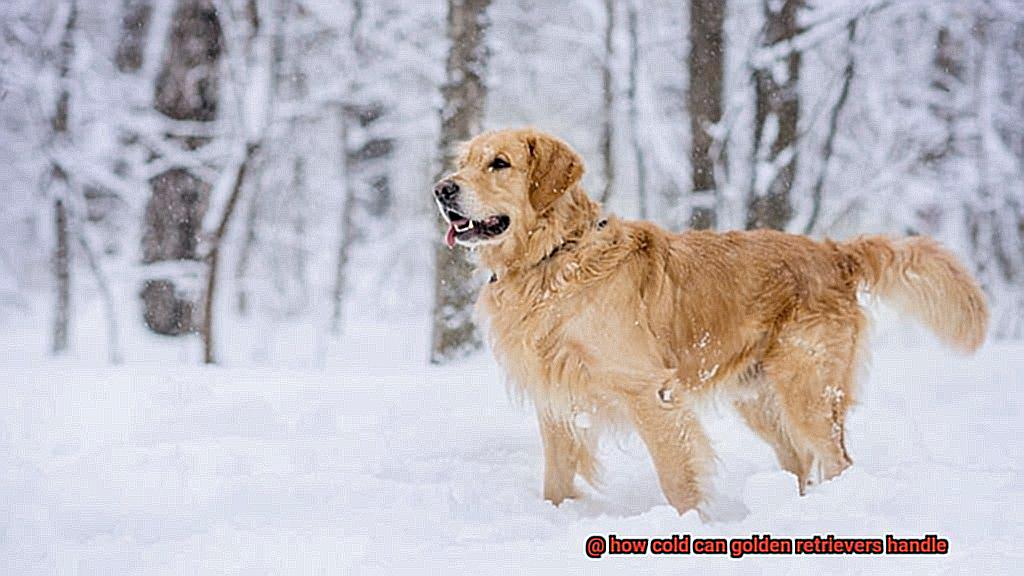Are you ready for the winter months with your furry friend? As the temperature drops, it’s important to understand how much cold your dog can handle. Golden Retrievers, known for their thick fur and active nature, are often considered a breed that loves the cold. But just like any other dog, they have their limits.
In this article, we’ll dive into the question of how cold can golden retrievers handle and provide valuable information on keeping them safe and healthy during chilly weather. We’ll explore the typical temperature ranges that golden retrievers can comfortably tolerate and highlight warning signs that indicate when it’s too cold for your dog outside.
We’ll also share practical tips on how to keep your golden retriever warm during the winter season, such as investing in insulated jackets or providing extra bedding. Additionally, we’ll discuss vital measures to prevent hypothermia or frostbite from affecting your furry friend.
So whether you’re planning a snowy adventure or just taking a walk around the block, read on to discover everything you need to know about how cold can golden retrievers handle and ensure your pup stays cozy all winter long.
Factors that Affect a Golden Retriever’s Tolerance for Cold Temperatures
Contents
Golden Retrievers, with their thick double coat, are generally well-equipped to handle colder temperatures, but there are still several factors that can affect their comfort levels.

The thickness, length, and texture of a dog’s coat are the primary factors that impact its ability to handle the cold. Golden Retrievers have a thick double coat that provides insulation and protection against the elements, but it needs proper maintenance to remain effective. Regular grooming and brushing can help keep their coat healthy and prevent matting, which reduces its insulating properties.
Age and health also play a role in a Golden Retriever’s tolerance for cold temperatures. Older dogs, puppies, and those with underlying health conditions may struggle to regulate their body temperature and be more susceptible to the cold. It’s important to monitor their behavior and body language during colder weather conditions to ensure they’re comfortable.
A dog’s activity level can also impact how well they handle the cold. Active dogs generate more body heat and are better able to maintain their body temperature in colder weather. On the other hand, less active dogs or those who spend most of their time indoors may have a harder time adapting to colder temperatures.
Finally, the climate in which a Golden Retriever lives can also impact its tolerance for cold temperatures. Dogs that live in colder climates may be better adapted to handle colder temperatures than those in warmer climates. However, even dogs used to colder climates can still be affected by extreme cold and should be monitored closely during periods of harsh weather.
Ideal Temperature Range for Golden Retrievers
They are known for their thick, double coat that helps them regulate their body temperature in varying weather conditions. However, just like humans, Golden Retrievers have their limits when it comes to extreme temperatures.
Through extensive research, I have discovered that the ideal temperature range for Golden Retrievers is between 60°F and 80°F (15.5°C to 26.5°C). Temperatures below this range can be uncomfortable for them and may lead to health issues. When the temperature drops below 45°F (7°C), it can cause them to shiver and eventually lead to hypothermia, which can be life-threatening.

On the other hand, high temperatures above 85°F (29.4°C) can also be dangerous for Golden Retrievers. As they don’t sweat like humans, they rely on panting to cool off. But when the air temperature is too hot, it becomes difficult for them to regulate their body temperature, leading to heat exhaustion or heatstroke.

It’s essential to note that the ideal temperature range may vary depending on the individual dog’s age, health condition, activity level, and coat thickness. That’s why it’s essential to monitor your furry friend’s behavior and look out for signs of discomfort or distress in extreme temperatures.
Protective Gear for Cold Weather
When temperatures plummet and cold winds start to howl, even the most luxurious coat may not be enough to keep your furry companion warm and protected.

That’s where protective gear for cold weather comes in. By providing your golden retriever with the right gear, you can ensure their safety, comfort, and well-being during the chilly months.
When the mercury drops below freezing, it’s crucial to put a coat or sweater on your dog. Look for materials that are both insulating and breathable, such as cozy fleece or wool. A well-fitted coat will not only keep your dog warm but also shield them from wind and moisture.
If your dog is going to be exposed to cold and wet conditions for an extended period, hypothermia can become a serious threat. So invest in waterproof boots for their paws and a waterproof jacket to keep their coat dry. These will help prevent them from losing body heat and shivering uncontrollably.
Don’t forget about protecting your dog’s ears and paws from frostbite. Ear muffs or a snood can keep their ears warm and cozy, while paw balm or booties can help shield their paws from the biting cold ground.
Individual Differences in Tolerance for Cold Temperatures
Golden retrievers are generally a cold-tolerant breed, but just like humans, they have their unique ways of handling extreme temperatures. Factors such as age, size, weight, coat type, and overall health can all affect a dog’s tolerance for cold.
Young puppies and older dogs tend to struggle with colder weather as they may be less able to regulate their body temperature. Smaller dogs also have a harder time retaining heat, so they may need extra protection in colder climates.
A golden retriever’s coat thickness and length are also crucial factors to consider. Dogs with thicker, longer coats are better equipped to handle colder temperatures than those with thinner coats. However, even dogs with thick coats can still be susceptible to hypothermia if they get wet or are exposed to extreme cold for prolonged periods.
Overall health is another critical factor to take into account. Dogs that are underweight, have a weakened immune system, or have certain medical conditions may not be able to handle the cold as well as healthy dogs.
As an owner of a golden retriever, it’s essential to pay attention to your dog’s behavior and physical cues when they are outside in the cold. Signs that your dog may be too cold include shivering, lethargy, and reluctance to move or play. If you notice any of these signs, take immediate steps to keep your furry friend warm and comfortable in the cold weather.
To ensure your golden retriever stays warm and safe during the winter months, consider providing them with a warm shelter or coat and limiting their time outside in extreme temperatures.
Precautions During Extreme Weather Conditions
When it comes to extreme cold weather, it’s crucial to take extra precautions to ensure their safety and comfort.
First and foremost, it’s important to understand that not all dogs have the same tolerance for cold temperatures. Factors such as age, weight, and overall health can impact how well your golden retriever can handle the cold. A good rule of thumb is that if you’re feeling uncomfortable in a certain temperature, your dog probably is too.
To keep your golden retriever safe and healthy during extreme cold weather conditions, you’ll want to keep a close eye on them. Ensure they have access to shelter and a warm place to rest. If they are outside for extended periods of time, provide them with a coat or sweater to help keep them warm. Think about it this way: if you need a jacket to stay warm, so does your pup.
It’s also important to watch out for signs of hypothermia in your golden retriever. These could include shivering, lethargy, difficulty walking, and even unconsciousness in severe cases. If you notice any of these symptoms, bring your dog inside immediately and contact a veterinarian right away.
Keeping your golden retriever well-fed and hydrated during cold weather is essential. Cold weather can cause a dog’s metabolism to increase, which means they will burn more calories to stay warm. Make sure they have access to plenty of water and food so they can maintain their energy levels.
If you’re planning on taking your golden retriever for walks during extreme cold weather conditions, be sure to limit the duration of the walks and keep them on a leash. This will help prevent them from getting lost or injured in icy or snowy conditions.
Conclusion
In conclusion, keeping your golden retriever safe and comfortable during the winter months requires an understanding of their cold tolerance. While goldens are generally able to handle chilly weather, several factors can impact their ability to do so, including age, health condition, activity level, coat thickness, and climate. To ensure your furry friend stays warm and happy during colder temperatures, it’s important to monitor their behavior and physical cues when they’re outside.
The ideal temperature range for golden retrievers is between 60°F and 80°F (15.5°C to 26.5°C). Anything below this range can make them uncomfortable and even lead to serious health issues like hypothermia or frostbite. That’s why it’s crucial to invest in protective gear such as coats or sweaters, waterproof boots, ear muffs or snoods, and paw balm or booties.
When the weather turns extreme, you’ll need to take extra precautions to keep your golden retriever safe. This includes providing access to shelter and a warm place to rest, limiting the duration of walks and keeping them on a leash for added protection, watching out for signs of hypothermia or frostbite, and ensuring they have plenty of water and food.
By following these tips and taking care of your furry friend during chilly weather conditions, you can enjoy cozy winter days together without worrying about their safety. Just remember that like humans, dogs have limits when it comes to extreme temperatures.









